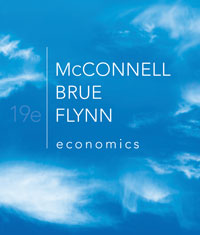Economics (McConnell) AP Edition, 19th EditionWeb Chapter 11:
Technology, R&D, and EfficiencyWorked ProblemsProblem 11W.1 - Optimal R&D expenditures Problem: Suppose a firm expects that an initial expenditure of $1 million on R&D will return $1.25 million one year from now. - What is the expected rate of return on this R&D expenditure? Enter the value in the table below.
- If the firm can borrow funds at an interest rate of 7%, will it undertake this expenditure?
- Suppose additional expenditures on research and development have marginal expected rates of return as shown in the table below:
R&D Expenditures, Millions | Expected Rate of Return | $1 | | 2 | 20% | 3 | 15 | 4 | 11 | 5 | 8 | 6 | 6 | 7 | 5 | 8 | 4 |
If the firm can expand its borrowing without limit at 7% interest, how much R&D spending is optimal for this firm?
| Answer: - The expected rate of return is 1.25/1 = .25, or 25%.
- The firm will undertake the expenditure, as the expected rate of return (25%) exceeds the cost of the borrowed funds (8%).
- The firm will expand its R&D expenditures as long as the expected rate of return exceeds the interest rate. In this example, the firm's optimal R&D expenditures will be $5 million. The expected rate of return on the next (i.e., the sixth) millionth dollar of expenditure is only 6%, less than its expected rate of return.
|
Problem 11W.2 - Process innovation Problem: Suppose a firm uses 5,000 worker hours and 7,000 units of raw materials in combination with its capital stock to produce 1,000 units of output. Its fixed capital costs are $40,000; it pays its labor $10 per hour and its raw materials cost $6 per unit. - What is the total cost of producing 1,000 units of output? What is the average total cost of producing 1,000 units of output?
- Suppose the firm improves its production processes such that it can now use the same amount of resources to produce 1,100 units of output. What are the firm's new total cost and average total cost of producing 1,100 units of output?
- Alternatively, suppose the firm were to continue to produce 1,000 units of output using the new production process rather than 1,100. What can you say about its total cost and average total cost of 1000 units of output?
| Answer: - The firm's total cost is the sum of its capital, labor, and materials costs. Its labor cost is $50,000 = $10 per hour times 5,000 worker hours. Its materials cost is $42,000 = $6 per unit times 7,000 units. Including its fixed capital costs of $40,000, its total cost is then $40,000 + $50,000 + $42,000 = $132,000. Its average total cost of 1,000 units is $132,000 / 1,000 = $132.
- Since it is using the same amount of resources, the firm's total cost remains $132,000. However, the average total cost falls to $120 because its output has expanded. $132,000 / 1,100 = $120.
- Since the new process can use the same resources to expand production, presumably it would require fewer resources to continue to produce 1,000 units. This would reduce the firm's total cost and its average total cost. For example, suppose the new process required using only $125,000 worth of resources to produce 1,000 units of output. The firm's average total cost would fall to $125,000 / 1,000 = $125.
|
 |  |





